SPM
A single point mooring (SPM) is a floating buoy or jetty anchored offshore for handling liquid cargo such as petroleum products for tanker ships deployed in areas where a dedicated facility for loading or unloading liquid cargo is not available. A SPM is an all-weather facility and sometimes the cheapest entry point for liquid cargo. SPM is an open sea anchorage with sub-sea and subsoil pipelines connecting it to on-shore facilities and has revolutionised the handling of imported crude oil and other petroleum products. SPM is usually located at a distance of several kilometres from the shore facility .Single-point mooring facilities can even handle vessels of massive capacity such as VLCC and SPM systems are designed to accommodate deep draft tankers while they transfer crude oil and fuel oil to and from shore. Typical designs are single anchor leg mooring (SALM), catenary anchor leg mooring (CALM) and an articulated column system. There are about 50 SALM and 150 CALM systems in operation throughout the world. The common features of these two systems are the rotating head on the buoy and the vertical chain that anchors the buoy to the seafloor.
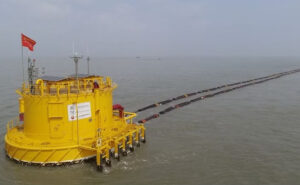 Credit; Financial Times
Credit; Financial Times
Sheltered Areas & CBM
There are a number of different terminals located offshore, outside port limits or in sheltered anchorage areas ,where larger ships which cannot approach ports or terminals ashore are berthed and the cargo transfer is carried out offshore .A typical Conventional Multi-Buoy Mooring (CBM/MBM), Single Point Mooring (SPM) and conventional Single Anchor Loading (SAL) system are designated for connection to amidships cargo manifold of a standard trading tanker taking into account the hydro-meteorological boundary conditions (weather limitations) enabling ships to carry out safe cargo and manoeuvring operations offshore. The permanently moored vessels FSO/FPSO and shuttle tankers with Bow Loading Systems are excluded from this scope. A Conventional Buoy Mooring known also as Multiple Buoy Mooring (MBM) main components consist of mooring system with buoys, mooring legs and anchor points, pipeline end manifold (PLEM), pipeline to shore, subsea control system and hose string with pick-up arrangement . Multiple buoys are fixed to the seabed by means of mooring lines and marine anchors in a rectangular pattern that allow safe mooring of a vessel which is positioned between the buoys with tug assistance. Conventional buoy mooring system and single point mooring system are commonly deployed by conventional tankers or storage unit FSO on shallow waters . A CBM may be found in shallow waters up to 30 m depth and SPM up to 100 m depth.
Bangladesh opts for SPM
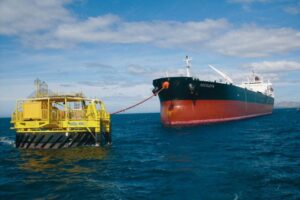 Credit ;The Financial Express
Credit ;The Financial Express
The maiden SPM system of Bangladesh has commenced trial operations in the Bay of Bengal and presently serves the purpose of transporting petroleum products from offshore vessels to onshore storage facilities. Bangladesh annually imports around 7.0 million tonnes of combined crude and refined oils and its only refinery, Eastern Refinery Ltd (ERL), a wholly-owned subsidiary of BPC, typically imports around 1.50 million tonnes of crude oil annually for domestic refining purposes. When the SPM becomes commercially operational Bangladesh is likely to annually save around US$ 75 million through reduction in transportation costs of petroleum products from outer anchorage to onshore fuel tankers. The BPC is implementing this project at a cost of around Bangladeshi Tk 65 billion, with Chinese financial assistance.The government contributed around Tk 12 billion, BPC around Tk 6 billion and the remaining Tk 46 billion is project assistance.The SPM project includes installation of a 220 kilometre pipeline mostly laid in the Bay of Bengal. Construction works for the fuel pumping stations and 6 fuel storage tanks have been completed. The storage tanks have a combined capacity of approximately 240,000 tonnes of petroleum products comprising 150,000 tonnes designated for crude oil and 90,000 tonnes for gasoil.
As imported petroleum cannot be directly offloaded into Chattogram storage tanks large tankers anchor in the deep sea and smaller vessels unload the petroleum products and transport to onshore storage facilities. To transport petroleum products from large mother vessels at the outer anchorage to the onshore tanks the BPC pays approximately US$ 5.50 per tonne to lighters or small vessels owned by the state owned Bangladesh Shipping Corporation .The process of offloading oil from tankers can take up to 7 days sometimes resulting in fines for time overruns incurred by the BPC. The SPM will enable offloading of 120,000 tonnes of crude oil within 48 hours and 70,000 tonnes of gasoil (diesel) within 28 hours , a huge cost saving.
Pakistan enters SPM Club
Pakistan in the year 2012 joined the club of countries with single point mooring facilities in the deep sea to transport crude oil through a pipeline to the refineries set up along the coast. A refinery Byco at Hub, Balochistan saves millions of dollars in demurrage due to quick disposal of imported crude oil. The refinery has a 28-inch 15 km pipeline at the seabed at a depth of 26 metres and the SPM pumps crude oil to its coastal refinery.The pumping capacity of the SPM is more than 2,000 tons / hour and equipped with night navigation facility. Byco refinery is currently refining 35,000 tons of crude oil a day.
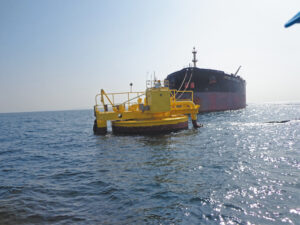 Credit;Express Tribune
Credit;Express Tribune
The SPM’s cargo carries a quantity of 79,000 tons. Sometimes an oil vessel is anchored about 65 km offshore in the Arabian Sea near the floating buoy with a cargo of 65,000 tons of crude oil . The strategic location of the SPM can curtail the distance from Middle Eastern ports by around 100 nautical miles per trip generating additional savings in freight cost and no sovereign guarantees are required . Previously two oil terminals in Karachi namely Karachi Port Trust and Fauji Oil Terminal (Fotco) located at Port Qasim handled all Pakistan’s oil imports. Crude oil and petrol were handled at Karachi Port’s Keamari Terminal while diesel, furnace oil and petrol imports were handled at Fotco . Severe congestion at the ports in marine traffic and the infrastructure would occur as carriers had to wait offshore to unload and demurrage incurred was conveniently passed on to the consumers .
Typical hazards and risks to SPM terminals
- Tanker or random vessel collision with the SPM
- Annual weather conditions cause cessation of SPM activities
- Tsunami , Monsoon or other exceptional surface wave event
- Exceptional wind behaviour
- Hydrological variations, siltation due to breakwaters construction or unplanned coastal degradation
- Disincentive for maintaining existing or expanding infrastructure such as oil piers and manifold and distance from refineries and logistics rail infrastructure
Floating Storage Facility
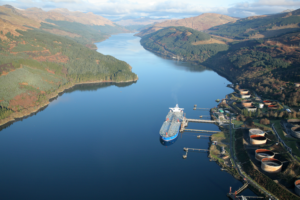 Credit; Petroineos
Credit; Petroineos
The VLCC “Australis” has been moored at Finnart Oil Terminal , Scotland since the year 2019 , primarily serving as a floating storage facility rather than an active transport vessel. The tanker was reportedly chartered for a two-year period at a rate of approximately $20,000 per day . The Australis has pipes overhanging its hull to allow other tankers to discharge cargo alongside as its usual role in lighterage and storage operations. At times the VLCC is utilised to store crude oil in view of volatile market conditions , energy supply chain security or logistical needs tied to the terminal’s operations.The Grangemouth Refinery is connected through pipelines to the Finnart Oil Terminal and remains a key facility for handling large oil tankers of up to 324,000 tonnes and crude oil is transferred via a 58 mile long pipeline .
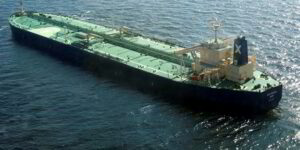 Credit;TradeWinds
Credit;TradeWinds
The use of VLCCs for storage is ideal when oil markets fluctuate or when refining capacity is limited. The Australis is a 299,000 dwt tanker (built in 2003) at a storage charter cost of $ 20,000 per day and as Scotlands only refinery is set to cease refining operations this year it would be interesting to see if the the role of the VLCC Australis is to be deployed as a storage asset elswhere , perhaps even at Karachi Port Deep Water basin.
By Nadir Mumtaz
Trade Mark (Registered) Blue Economy
Credit/Sources;
https://www.marineinsight.com/offshore/how-single-point-mooring-spm-offshore-operation-works/
https://www.sciencedirect.com/topics/engineering/single-point-mooring
https://www.nation.com.pk/27-Jan-2022/cnergyico-s-single-point-mooring-helps-unclog-oil-terminals
https://www.gallthomson.com/en/guides/underbuoy-breakaway-couplings/spm-single-point-moorings-risks
https://dailyindustry.news/spm-for-fuel-supply-to-save-tk-800cr-yearly/
https://www.petroineos.com/refining/grangemouth/
https://www.tradewindsnews.com/tankers/chandris-lands-two-year-storage-deal-for-vlcc/2-1-308976

Leave A Comment